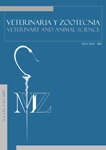Authors
Abstract
ABSTRACT: Two experiments to determine nutritional requirements of crude protein (CP) for leghorn laying hens and brown laying hens during the first productions phase (19 to 29 weeks old) were carried out, in order to assess and establish the crude protein effect on laying hens under premontane humid forest conditions. Three hundred Hy-Line W- 36® hens were used in the first experiment and 200 Hy-Line Brown® hens were used in the second one, distributed in an experimental complete randomized design (CRD), with five treatments, five repetitions and 12 “Hy line W36” fowl and 8 “Hy line Brown” fowl per experimental unit. The fowl were fed with a basic corn diet and soybean meal, with 2800 kcal ME/kg and five CP levels (14, 15, 16, 17 and 18%). Statistic differences (P>0.05) were not found in the egg production variables, feed conversion, food intake, eggs per housed fowl and feces dampness both in leghorn brown laying hens. Meanwhile, the production peak age decreased with the increase in the protein level in leghorn laying hens, while the weight profit increased with the growing levels of CP. It’s possible to feed leghorn and brown laying hens in premontane humid forest conditions with 14 to 17% CP levels, in order to obtain good eggs production, provided that fowls are given the daily quantity of essential and limiting aminoacid and a gain of suitable body weight is maintained.
Keywords
References
Bonekamp, R.P.; Lemme, A.; Wijitten, P.J.; Sparla, J.K. Effects of amino acids on egg number and egg mass of Brown (heavy breed) and White (light breed) laying hens. Poultry Science, v.89, n.3, p.522- 529, 2010.
Farran, M.T.; Dakessian, P.B.; Darwish, AH. et al. Performance of broilers and production and egg quality parameters of laying hens fed 60% raw or treated common vetch (Vicia sativa) seeds. Poultry Science, v.80, n.2, p.203-208, 2001.
Fasuyi, A.O.; Dairo, F.A.S.; Olujimi, O.T. Protein supplementary quality of vegetable leaf meal (Amaranthus cruentus) in the diets of laying hens: Egg laying performance, egg quality and heamatological implications. Journal of Food, Agriculture & Environment, v.5, n.3-4, p.294-300, 2007.
Filho, J.J.; Vilar da Silva, J.H.; Lindolfo da Silva, E. et al. Methionine + cystine requirements of semi-heavy laying hens from the starter to peak of egg production. Revista rasileira de Zootecnia, v.35, n.3, p.1063-1069, 2006.
Fru-Niji, F.; Niess, E.; Pfeffer, E. Effect of graded replacement of soybean meal by faba beans (Vicia faba L.) or field peas (Pisum sativum L.) in rations for laying hens on egg production and quality. Journal of Poultry Science, v.44, n.1, p.34-41, 2007.
Hammershøj, M.; Steenfeldt, S. Effects of blue lupin (Lupinus angustifolius) in organic layer diets and supplementation with foraging material on egg production and some egg quality parameters. Poultry Science, v.84, n.5, p.723-733, 2005.
Harms, R.H.; Russell, G.B.; Sloan, D.R. Performance of four strains of commercial layers with major changes in dietary energy. The Journal of Applied Poultry Research, v.9, n.4, p.535-541, 2000.
Hy-Line Internacional, Variedad W-36 y Variedad Brown. Guía de manejo comercial. Manual. Estados Unidos, 2010. p.11-12-14-18.
Ibrahim, S.; Blair, R.; Jacob, J. Using reduced protein diets to minimize nitrogen excretion of layer. In: Department of Animal Science. Abstracts. University of BC, Vancouver, BC. V6T1Z4, 1992.
Keshavarz, K. The effect of different dietary protein levels in the rearing and laying periods on the performance of white leghorn chickens. Poultry Science, v.63, n.11, p.2229-2240, 1984.
Keshavarz, K.; Austic, RE. The use of low-protein, low-phosphorus, amino acid- and phytase-supplemented diets on laying hen performance and nitrogen and phosphorus excretion. Poultry Science, v.83, n.1, p.75-83, 2004.
Keshavarz, K.; Nakajima, S. The effect of dietary manipulations of energy, protein, and fat during the growing and laying periods on early egg weight and egg components. Poultry Science, v.74, n.1, p.50-61, 1995.
Lemme, A.; Rostagno, H.S.; Knox, A.; Petri, A. Responses of laying hens to graded levels of dietary methionine. 22nd World’s Poultry Conference, Istanbul, Turkey. (Abstr.) 2004.
Meluzzi, A.; Sirri, F.; Tallarico, N; Franchini, A. Nitrogen retention and performance of brown laying hens on diets with different protein content and constant concentrations of amino acids and energy. British Poultry Science, v.42, n.2, p.213-217, 2001.
North, M.O.; Bell, D.D. Manual de producción avícola. 3.ed. México: Editorial El Manual Moderno, 1993. 829p.
NRC. Nutrient Requirements of Poultry. 9th rev. ed. Washington, D.C.: Natl. Acad. Press, 1994. Pavan, A.C.; Móri, C.; Garcia, E.A., et al. Níveis de proteína bruta e de aminoácidos sulfurados totais sobre o desempenho, a qualidade dos ovos e a excreção de nitrogênio de poedeiras de ovos marrons. 568 níveis de proteína bruta e de aminoácidos sulfurados totais sobre o desempenho, a qualidade. R. Bras. Zootec, v.34, n.2, p.568-574, 2005.
Peebles, E.D.; Zumwalt, C.D.; Doyle, S.M. et al. Effect of dietary fat type and level on broiler breeder performance. Poult. Sci., v.79, n.5, p.629-639, 2000.
Robbins, K.R.; Saxton A.; Southern, L. Estimation of nutrient requirements using broken-line regression analysis. Journal of Animal Science, v.84, n.13, E-Suppl. E155–E165, 2006.
Rostagno, H.S.; Teixeira, A.L.F.; Donzele, J.L. et al. Tablas Brasileñas para Aves y Cerdos. Composición de Alimentos y Requerimientos Nutricionales. 2.ed. Brasil: Centro Editorial Universidad Federal de Vicosa - Departamento Zootecnia, 2005. 186p.
SAS Institute. SAS/STAT User’s Guide. Version 6. 5.ed. Cary, NC: SAS Inst. Inc., 2002.Sauer, N.; Emrich, K.; Piepho, H.P. et al. Meta-analysis of the relative efficiency of methionine-hydroxy-analogue-free-acid compared with dl-methionine in broilers using nonlinear mixed models. Poultry Science, v.87, n.10, p.2023-2031, 2008.
Sterling, K.G.; Costa, E.F.; Henry, M.H. et al. Responses of broiler chickens to cottonseedand soybean meal-based diets at several protein levels. Poultry Science, v.81, n.2, p.217-226, 2002.
Summers, J.D.; Leeson, S. Influence of diets varying in nutrient density on the development and reproductive performance of White Leghorn pullets. Poultry Science, v.72, n.8, p.1500-1509, 1993.

 PDF (Español)
PDF (Español)
 FLIP
FLIP










